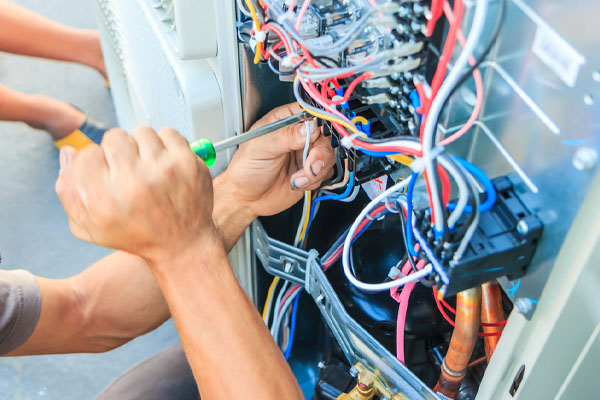How A Modulating Air Conditioner Controls Temperature & Humidity More Effectively

Air conditioners are evolving fast, especially regarding their requirements in energy efficiency. As a result, the variable-speed or modulating air conditioner is quickly replacing standard units.
A modulating air conditioning unit offers stable performance, intelligent energy usage, and more. These cooling units have more effective temperature controls and humidity reduction capabilities to achieve better comfort. Read on to learn more about variable-speed air conditioning systems.
Standard Units vs. Modulating Air Conditioners
Contents
Comparing modulating technology to standard units helps you fully understand and appreciate it. Standard or traditional air conditioning units have a compressor that has a fixed-speed operation. This means that it functions at 100% capacity when switched on and completely shuts down when turned off.
It may seem like a non-issue, but air conditioners like this use a significant amount of energy. Starting the cycles from scratch every time requires a lot of power. As a result, you will have a high energy bill.
Heating and cooling temperatures aren’t flexible with standard units because they have a fixed-speed operation. Airflow is typically extreme and intense, so the space is either very cold or very hot. This system also tends to generate cold or hot spots.
How Is A Modulating Air Conditioner Different?
Modulating units do not run at 100% capacity at all times. Instead, it can be modified to run from 40% and 120%. Therefore, your home’s temperatures become more even and less extreme. Balanced temperatures increase comfort and the airflow’s general quality.
Modulating air conditioners have a variable-speed compressor. It allows you to adjust the speed to meet your various heating and cooling needs. You can also control the unit’s energy consumption when you control its output.
Fixed vs. Flexible Temperature Control

A common phrase that describes how standard units usually work is “blast the AC.” It’s because you switch the unit on, and it blows air into the room at full speed. Therefore, the temperature is generally either hot or cold.
Aside from the limited temperature settings, there’s typically too strong airflow. The areas in your home that receive little airflow will become hot or cold spots. This means you’ll have an uncomfortable home, especially at night.
This is solved with HVAC modulating technology as it provides adjustable settings. Variable-speed systems are designed to change the airflow per the home’s needs. It offers a less intense output, so extreme temperatures and hot or cold spots are effectively removed.
Air conditioners equipped with two or more speeds give you a more consistent and steady airflow. These units can also be customized per your preferred temperature settings. Having output control capabilities means you can match the system according to your cooling preferences.
Remember that other factors can also impact the airflow quality. It is best that you install the modulating air conditioner according to your home’s specifications so that it functions at its peak. Consult a professional HVAC service provider to know more information.
High vs. Low Indoor Humidity Levels

Traditional air conditioners need on and off cycles more frequently. When the unit restarts its cooling cycle, it may not get the chance to dehumidify the air in your home. As a result, there will be higher humidity.
As a result, it is common for standard units to leave homes feeling clammy and uncomfortably warm. Humidity also encourages mold to grow. Mold can cause home damage and negatively affect your health.
Modulating or variable-speed air conditioning systems are made to keep mold from growing. These air conditioners effectively reduce water in the air because they need fewer cycles. This means there is less humidity. You can raise the temperature on your thermostat without worrying about feeling clammy or having molds around your home. This means they can filter indoor pollutants out of the air since the units run longer, significantly improving indoor air quality.
Most modulating units don’t let the humidity go over 50%. Regulating authorities highly recommend this humidity level. The bad news is that standard fixed-speed units can allow the humidity to rise to 60%. This creates a breeding ground for mold, so the units may need to be replaced down the line. This can be prevented with good maintenance.
Remember that modulating air conditioners aren’t designed to be equal. It isn’t guaranteed that a model will automatically reduce your home’s humidity. You should consult an HVAC professional to know about your options and ensure you get this feature.
Set vs. Smart Energy Consumption
High power consumption is probably normal if you use a standard air conditioner. This is especially true during the summer or the months when there are extreme weather temperatures.
Homeowners usually have to put additional insulation or boost the airflow through other means to lower their energy costs. Unfortunately, high energy bills are inescapable with standard air conditioners unless you use them less. This isn’t a cost-effective option.
Modulating air conditioning systems were designed to fix this issue. Having variable speeds translates to producing different outputs. An air conditioner running at 40% capacity doesn’t utilize the same power as one operating at 100%. It allows homeowners to control how much power the unit uses or keep the AC on without much energy consumption.
HVAC Maintenance Costs vs. Short Payback
Modulating air conditioners help you save on energy costs that ultimately cover the equipment, maintenance, and installation price. This means that modulating air conditioning systems have a relatively short payback period.
There are several ways you can cut the costs of air conditioner maintenance. However, standard models still cost more down the line. Fixed-speed air conditioners suffer from more strain and pressure than their variable-speed counterparts. Repeated stress on your HVAC system means it requires more repairs and part replacements.
Conclusion
The rise in energy efficiency saw the inevitable transition of standard air conditioners to modulating types. Inverter technology innovations offer low-cost heating and cooling solutions. Moreover, variable-speed units have better temperature and humidity controls, so you can have a smarter, greener, and more comfortable home.
Call R.F. Ohl For All Of Your HVAC Requirements

For top-notch heating and cooling services in the Poconos and the Lehigh Valley, Pennsylvania, call R.F. Ohl. We have the best professionally certified and highly skilled technicians on staff, so you are assured of excellent HVAC replacements, tune-ups, repairs, and installations every time. All our friendly techs are experienced, skilled, and knowledgeable to service your HVAC system correctly and promptly.
R.F. Ohl offers highly competitive heating and cooling service prices. Our maintenance services help increase energy efficiency and improve comfort while lowering your home’s energy bills. If you need an HVAC repair or replacement system, we can recommend the most suitable solution for your home within your budget. Your satisfaction is important to us, so all our work is guaranteed. Book your next service appointment with R.F. Ohl today. We offer free, in-home estimates.
Click here to contact us today or give us a call at (610) 377-1098 if you have any questions.